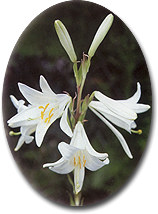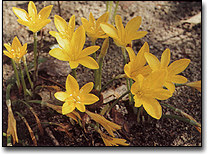Flora & Fauna
The wide variation in topography and climate; the fact that Turkey is surrounded by four seas, each with its own ecological constitution; and the relatively late development of industry and agriculture has resulted in an phenomenal wealth of plant and animal life within Turkey’s borders. This extraordinary degree of biodiversity was augmented during the Ice Age, when northern animals strayed south seeking warmer climes, and many remained in their new homelands. Turkey is also situated on the main migratory routes for birds between Asia, Africa and Europe, thus increasing the number of species found here.

Anatolia as a Gene Centre
Turkey has almost as many species of wild flowers as the rest of Europe combined; of the over 9000 species so far identified more than one third are native to the country, many found nowhere else on earth. Turkey is regarded as an important gene centre for many cultivated crops, whose wild ancestors can still be found growing in Anatolia. The defence mechanisms and disease resistence of the wild forms tend to be more highly developed than those of the cultivated plants and can be transmitted through biotechnology. The wild forms remain a fundamental reference source when developing new and improved strains. Turkey is the home of over thirty species of wild wheat, along with barley, chickpeas, lentils, apricots, figs, cherries and many types of nuts. A large number of ornamental flowers were cultivated from Turkish wild forms, including most famously the tulip but also the crocus, snowdrop, and lily.
Anatolia is similarly rich in fauna, with over 80,000 species. It is the original homeland for the fallow deer, the pheasant and the domestic sheep. Lions, tigers and leopards once prowled freely across the Anatolian steppe. Today, the mountains and national parks still abound with wildlife, such as brown bears, wild boar, lynx, wolves, water buffalo, the occasional leopard and over 400 species of birds, several of them endangered. Turkey’s Mediterranean and Aegean coasts provide refuge for the endangered monk seal andthe logger-head turtle. Of the world’s 300 remaining monk seals, 50 live in Turkish waters.
Floral Regions
Much of the coastal and more temperate areas of Turkey are covered in maquis (dwarf forest) or Red Pines, which require little water to tide them over dry summers. They are, however extremely susceptible to the forest fires which destroy around 20,000 hectares of Turkey’s forests annually. At higher altitudes woods of plack pine, fir and cedar grow. The mild Mediterranean climate enables the valleys and lowlands to grow a range of tropical fruit. As tastes in urban centers broaden to include more ‘exotic’ fruit, the market garden industry has responded by expanding its range which in recent years has included homegrown kiwis, bananas, avocado and mushrooms. The Aegean region in particular is known for its olives, grapes, cotton and tobacco.
The higher slopes of the verdant Black Sea region are thick with beech, oak, maple, alder, Scots Pine, and Oriental Spruce, while the narrow coastal strip and lower slopes are used to grow tea, hazelnuts, flax, maize, cherries and plums. All of these plants are suited to a temperate climate with plenty of rain — never a problem in the Black Sea region.

Steppe is the most common landscape in Turkey today, stretching all the way from Thrace to the Iran/Iraq border. Thousands of years of deforestation and erosion has increased it from 15% to 35% of the total land area of Turkey. Steppe is characterised by the diversity of life which it sustains, especially in spring, when the rolling landscape is carpeted in a multicoloured profusion of delicate featured but hardy flowers, including daisies, crocuses, violets and poppies. This landscape has been the inspiration of carpet and kilim weavers for centuries. Much of Turkey’s western and central steppe is used for the cultivation of cereals, sunflowers and sugar beet, as well as pasture land for large herds of cattle and flocks of sheep. The further east one moves the more sparse and barren the landscape becomes, with alternating arid, semi-desert lowlands and towering mountain peaks.
Wetlands are extremely valuable ecosystems which are found in abundance in Turkey. Although they do not have the diversity of the steppe, they make up for this in an organic productivity as high as tropical rain forests. By international definition, there are nineteen Grade A wetlands in Turkey, five of which (Kusgolu, Goksu Delta, Sultansazligi, Lake Burdur and Lake Seyfe) are registered as wetlands of international importance under the Ramsar Convention. Rushes and reed, buttercups, water mint, waterlilies and tamarisks are commonly seen plants while the waters teem with plankton, algae and water weeds. As a result of this rich food source, the wetlands are inhabited by large flocks of birds, who require hugh amounts of food relative to body weight in order to survive. Species found include flamingos, wild ducks and geese, teal, herons and tern, and numerous endangered species such as the Dalmatian pelican, pygmy cormorant and the slender billed curlew. The Southeast is similarily a haven for threatened species. Biricek is one of only two places left on earth where the bald ibis nests.
Environmental preservation and conservation is in its infancy in Turkey, but many individuals and increasingly the government are aware of the incredible natural assets which Turkey posesses, and of the urgency of protecting them. Many international conventions have been signed and many projects are under way to protect threatened species and habitats. The caretta caretta turtle almost lost its
breeding ground at Dalyan to a hotel development, but public outrage and international attention had the area declared an Environment Protection Zone. Other areas of the coast are also being protected and studies of their habitats undertaken. Education and research programmes are being put in place by a number of environmental protection organisations.
